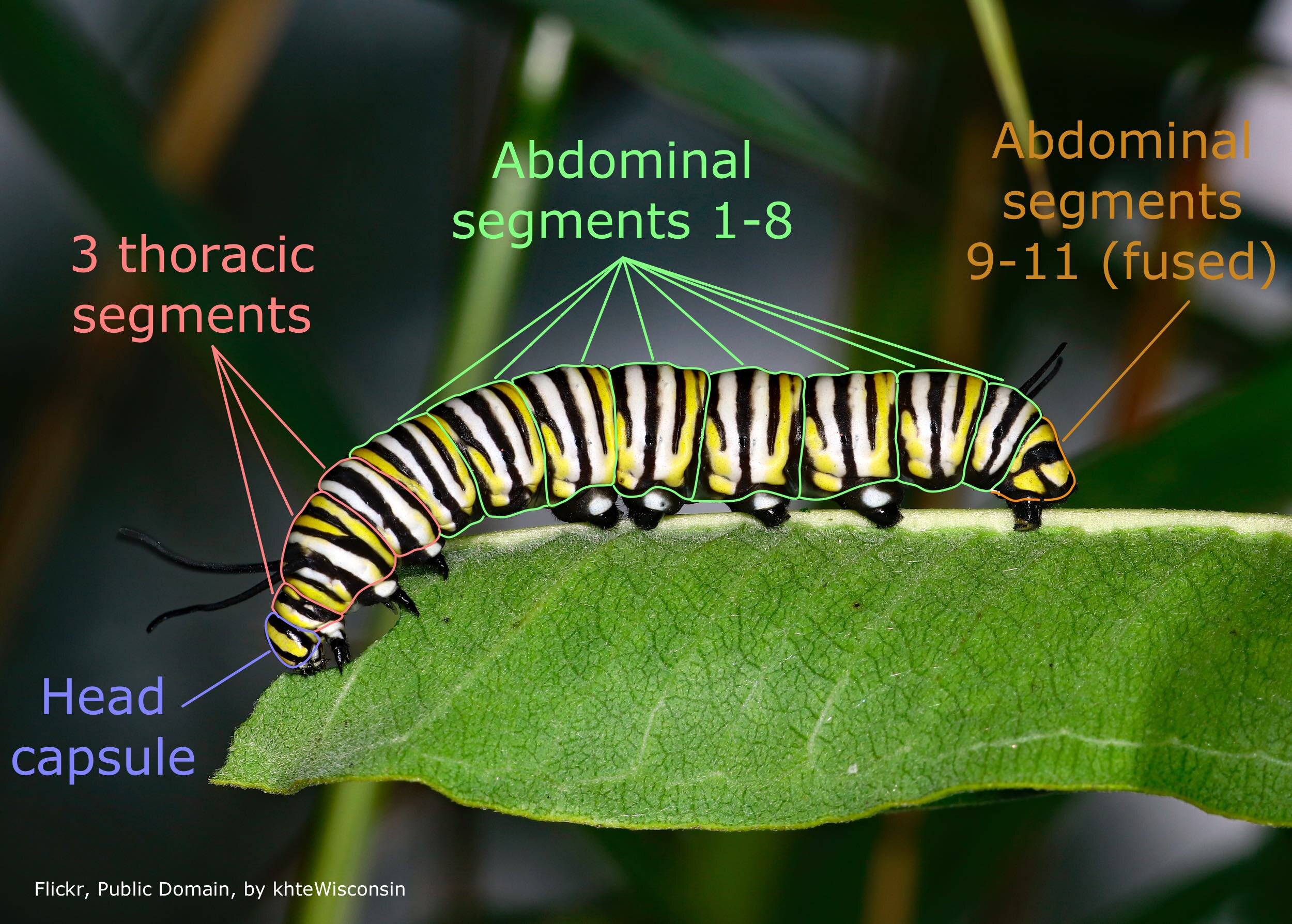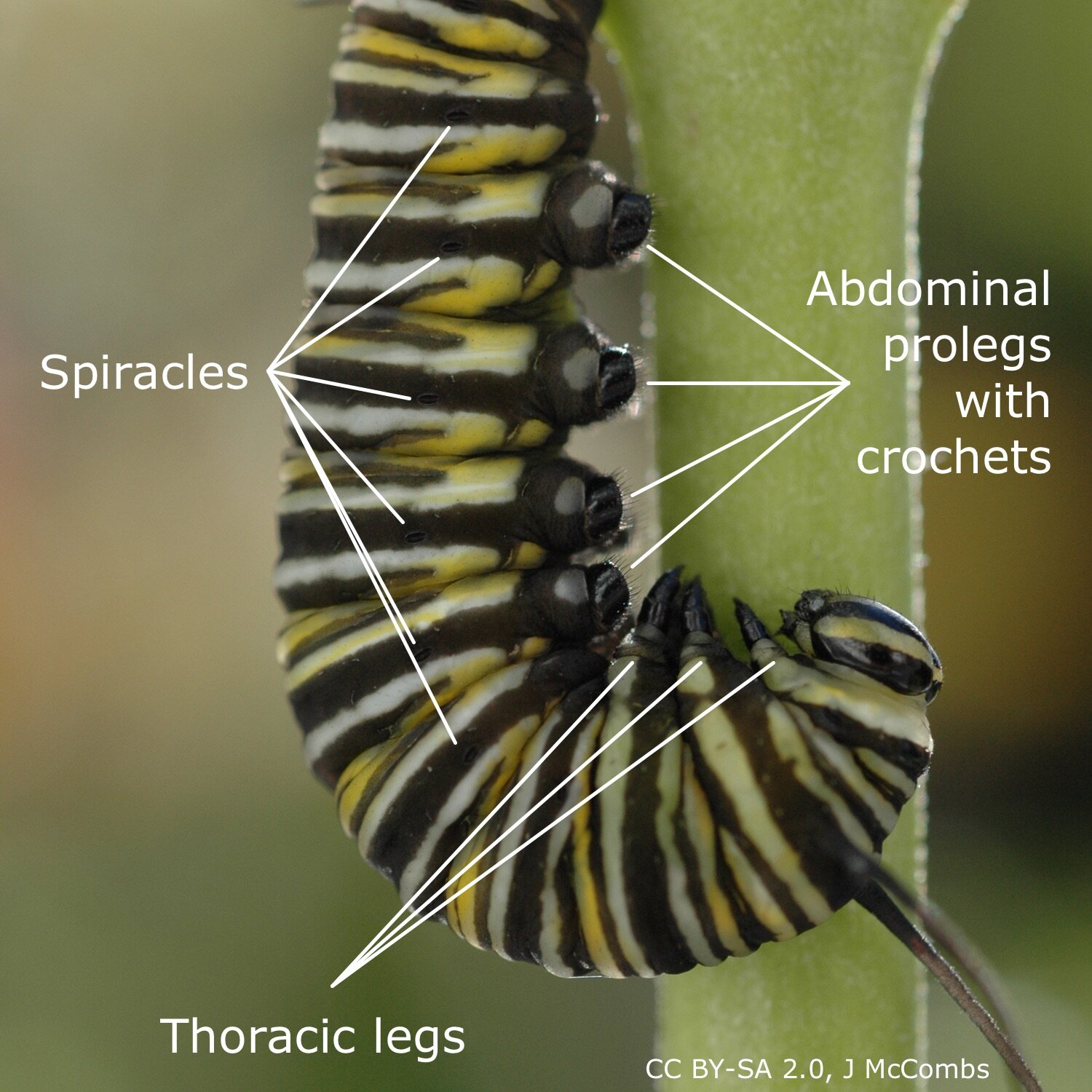| Raising monarchs | Eggs | Caterpillars | Chrysalis | Butterflies |
Monarch caterpillars
Caterpillars appear quite simple, but a closer look shows some interesting details.
Even at the caterpillar stage kahuku/monarchs (Danaus plexippus) have a head, thorax and abdomen1 (Figure 1).
Figure 1. Capterpillar body plan, showing the head, thorax and abdomen typical of insects
Monarch caterpillar heads
Eyes
The caterpillars have 6 pairs of ocelli2 (Figure 2). Ocelli are simple eyes that can only detect light and movement.
Tentacles
There are 4 tentacles (sometimes called filaments) - two on the front and two on the back (Figure 3).
The pair of tentacles on the head are the anterior tentacles. The back pair are the posterior tentacles, and are shorter.
The tentacles provide the caterpillar with a sense of touch. They may also help to confuse predators by making it unclear which end is the head3.
Antennae
The caterpillar’s tentacles are often mistaken for antennae. The actual antennae are quite short and very close to the caterpillar’s mouth (Figures 2 & 4). The antennae enable the caterpillar to smell and thereby find food3.
Spinneret
The spinneret, located below the mouth (Figure 4), spins silk. The caterpillars spin a silk pad each time they are about to moult. This provides them with a place to anchor while they wriggle free from their old skin.
When the caterpillar is ready to transform, it spins a silk button. The chrysalis attaches to the button while transforming into a butterfly . There is a nice photo of a spinneret by Monarch Watch4.
Figure 2. Head showing ocelli, antennae, anterior tentacles, thoracic legs.
Two types of legs
Monarch caterpillars have 3 pairs of true legs and 5 pairs of prolegs (Figure 3).
The true legs are on the thorax and are jointed. Each has a claw1.
The prolegs, sometimes called false legs, have no segments. They are located on the abdomen.
Prolegs hold the caterpillar onto a plant while they are feeding. The prolegs have many tiny hooks, called crotchets1 (Figure 5). The crotchets enable the caterpillar to anchor itself to a silk mat when they moult.
The anal prolegs are the pair at the back of the caterpillar (Figure 3). The caterpillar uses these when it hangs in the j-formation. It attaches the anal prolegs and then lets go with the other legs.
Figure 3. Thoracic legs, abdominal prolegs and tentacles on a monarch caterpillar.
Gas exchange
The small holes along the caterpillar’s body are spiracles (Figure 5). Spiracles allow air to travel into the body so the caterpillar can breathe. Air enters a system of tubes called trachea, within the caterpillar’s body. The trachea enable gas exchange to occur5.
Caterpillar stages - instars
The life cycle of a monarch includes 5 caterpillar stages known as instars6. Between instars the caterpillar sheds its skin so that it can grow larger. The process is called ecdysis.
The soft skin of a caterpillar allows growth to occur during each stage. But the head capsule and jaws need to be hard so the caterpillar can feed. The head capsule is shed with each moult, as the head increases in size.
The appearance of each instar is slightly different, see Figures 6-10. The head capsule gets larger, tentacles lengthen, and the stripy pattern on the body becomes more pronounced.
The earliest instar stages don’t particularly look like the later ones. They tend to be pale green or translucent, especially when newly hatched, and they lack the distinctive bands. Tentacles are barely visible2 and they are only around 2 mm long.
The final instar is the most patterned. It can reach 55 mm in length and weigh 1.5 g1
Related links:
| Raising monarchs | Eggs | Caterpillars | Chrysalis | Butterflies |
References
1. Gibbs, G. W., Berndt, Lisa, Pawson, S., Gibbs, G. W., & Entomological Society of New Zealand. The monarch butterfly in New Zealand. (2013).
2. Monarch Watch : Biology : Anatomy. https://monarchwatch.org/biology/index.htm.
3. What are monarch caterpillar’s tentacles and antennae for? The Monarch Joint Venture. https://monarchjointventure.org/resources/faq/what-are-monarch-caterpillars-tentacles-and-antennae-for.
4. Spinneret Image. Monarch Watch. https://www.monarchwatch.org/update/2002/spinneret.html.
5. Gullan, P. J. & Cranston, P. S. The insects: an outline of entomology. (Wiley-Blackwell, 2010).
6. Guide to Monarch Instars. The Monarch Joint Venture. https://monarchjointventure.org/monarch-biology/life-cycle/larva/guide-to-monarch-instars.
7. Moths and Butterflies of New Zealand Trust - Pūrerehua Aotearoa.












